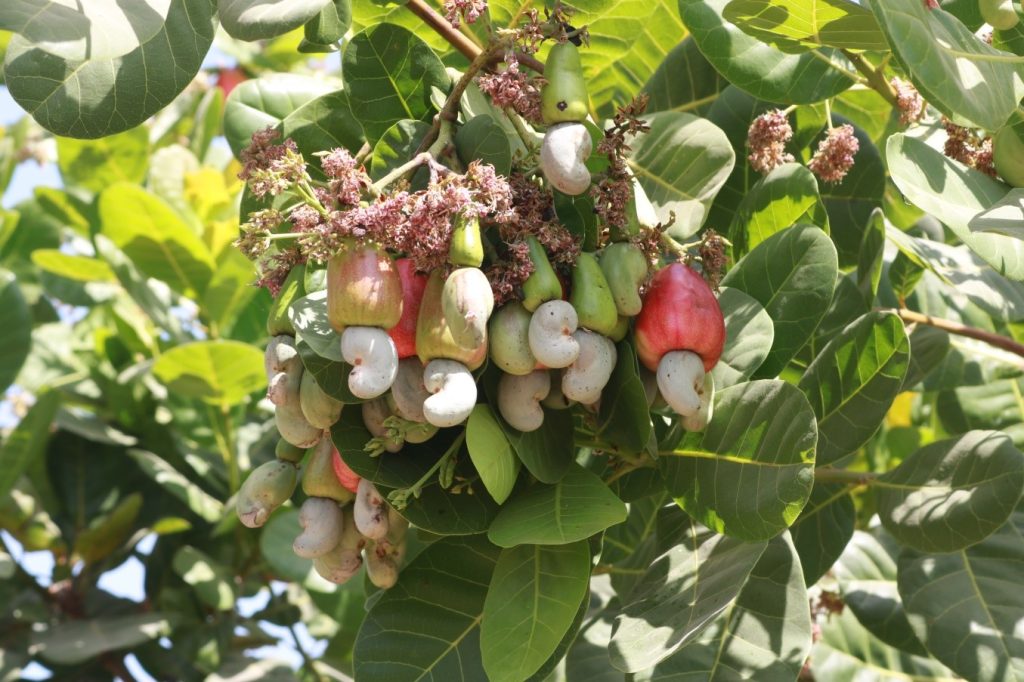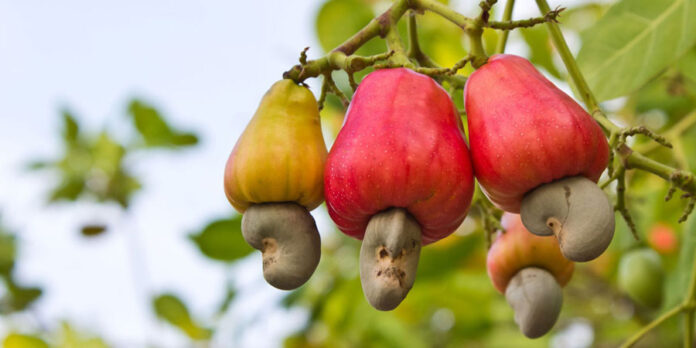Cashew cultivation has experienced significant growth due to its favourable agro-climatic conditions and government support for the cashew industry. Cashew trees thrive in various regions of Ghana, with the main producing areas being Brong-Ahafo, Eastern, Northern, and Volta regions.
Cashew (Anacardium occidentale) is an evergreen tree species grown predominantly for nuts. The tree produces an edible vitamin C-rich apple to which the nut is attached externally. Fruit colour on maturity ranges between red and yellow with many shades.
Climate and Soil Requirements
The tree loves full sunshine during the growing season and enough well-distributed rainfall for the best performance. In Ghana, the tree is best grown in the transitional zones though the Savannah has also shown promise.
Cashew tolerates a range of soil but most importantly well-drained with good organic matter concentrations, at all costs avoid heavy clay soils and stony soils and soils with high iron.
Soil Testing and Analysis
It is always advisable to precede any agricultural plantation development with proper soil testing; this will help direct how supplementary nutrition should be applied to seedlings and matured plants.
Watering and Irrigation
Watering of young trees is encouraged during the first year dry season, especially in very arid zones. Water is also important during flowering and fruit formation. Drip irrigation can be used in large plantations.
Land Preparation
Land must be prepared by removing vegetation cover, ploughing and harrowing for utmost performance. This is also to ensure drainage and good retention for growth.
Layout and Spacing
Pegging should be done at a spacing of 10m x 10m allowing for intercropping annual crops in the first few years. Generally within the transitional zone to the more humid areas of the country, the tree canopies will close by around 5 years, this takes longer in the drier savannah zones.
Intercropping with Other Crops
In deciding to intercrop under cashew cultivation, a distance of about a meter must be allowed between the cashew plants and the annual crop to avoid competition, which slows the growth of the cashew plants. The choice of intercrop should also consider crops that may share similar insects and diseases with the cashew crop like cowpea.

Planting Cashew Trees
Propagation Methods
Cashews can be propagated by seeds and grafted seedlings, however, to date the materials released are all available as grafted materials.
Seed Selection and Treatment
The recommended cashew planting materials released for plantation development are all provided as clones or grafted materials, these are to be sourced from licensed nurseries and other state nurseries like MOFA. Do not use seeds from trees you deem good for cashew cultivation, as these seeds may be segregating resulting in an entirely different material from the parent. It is best to rather graft from the parent since that will be true-to-type.
Planting Techniques
In the first two years, it is advisable to decap all flowers that are produced from your transplanted seedlings, this will allow the trees to grow well and bigger, developing bigger canopies for yield.
Nutrient Management
Cashew plants like any other plants require fertile soils for good growth, both organic and inorganic fertilizers can be used to achieve this.
Sulphate of ammonia (SOA): 149 g per plant, NPK (20:20:20): 200 g per plant. NPK 20: 10:10 could also be used. These can be applied in a split of halves. Fertilizer must be applied at least two weeks after transplanting. Apply fertilizer in a circular trench around the base of the plant and only when there is enough moisture in the soil. 10 kg of manure per plant can also be applied annually or bi-annually.
Common Pests and control in Cashew Cultivation
Adult Tea Mosquito Bug (Helopeltis spp.) are a major pest in cashew cultivation. They suck the new flushes rendering them dark and dead leaf miner, these mine the leaves and they become brown and die. Recommended pesticides like cyperdim can be used.
Weed Control
Ring weeding around the plant and general slashing and harrowing in between the lanes. This will reduce the incidence of pests and also reduce competition for nutrients, space, air and sunlight helping the healthy growth of the cashew plant. Intercropping with cover crops can also help to control weeds.
Pruning and Training
It is important to prune all side shoots below the graft union of transplanted seedlings after a month of establishment on the field. Formative pruning is encouraged to help shape the trees and also organize them for mechanical activities.
Harvesting and Post-Harvest Management
Determining the Right Time to Harvest
Nuts are ready when they start falling off the trees, however, for farms where fresh fruits will be needed, it is important to harvest when fruits are ripe and ready.

Post-Harvest Handling and Storage
Dressing of nuts is done by removing all pulp from their attachment to the nuts, the nuts are then dried in a shade away from direct hot sunlight to moisture below 14% before packaging into jute sacks and stored on pallets in well-ventilated warehouses
Processing and Value Addition
Nuts are processed to release kernels; these could be used for paste, roasted and eaten as snacks too. The fruits could be processed into jams, and squeezed into juice, alcohol could also be extracted from the juice and the chaff used in feeding livestock.
In conclusion
Current farmer yields are way below potential yields because of poor plantation management, which includes fertilization, pruning and insect and pest management. Improving these practices will greatly improve returns on investment (ROI).


